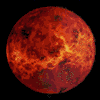Mars

Diameter=6,794 km or 53% that of
Earth
|
The last of the
terrestrial planets and fourth from the sun, Mars is the
second closest in similarity to Earth. It's day is almost
the same length, at 24 hours and 37 minutes, and it has many
similar surface features including enormous volcanoes, vast
canyons, dune fields, and dry channels. The planet's most
distinguishing feature is the Valley Marineris, a canyon
complex that stretches 5,000 km, far longer than any similar
feature on Earth. On a summer day Mars' temperature rises no
higher than 0 degrees C and at night most areas cool to -100
C. The only sign of water on Mars are the now dry channels,
and the currently existing northern polar ice cap. Mars is
called the Red Planet because of its reddish appearance in
the night sky, as well as on its surface. Exploration of the
Martian surface revealed no signs of life, only
boulder-strewn fields, sand dunes, and a weird pink sky.
Mars has two satellites,
Phobos and Deimos.
|